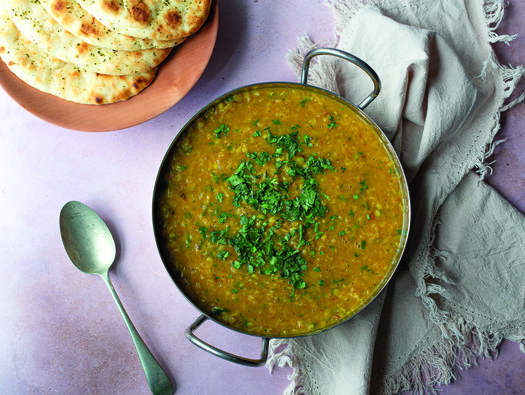Masoor dal

Using spices and making your own curry paste adds plenty of flavour without the salt.

Using spices and making your own curry paste adds plenty of flavour without the salt.
235g red lentils
1 medium tomato
1 medium onion
4 green chillies
750ml boiling water
2 teaspoons red chilli powder
½ teaspoon ground turmeric
1 teaspoon ground coriander
30g fresh coriander
1 teaspoon garam masala
2 tablespoons vegetable oil
50g unsalted butter
1 teaspoon cumin seeds
5 garlic cloves
4 mini naan breads or 2 regular naan, halved
Wash and soak the red lentils in warm water and leave for 30 minutes, then drain.
Using a blender or pestle and mortar, crush the tomato, onion and green chillies. Heat the 750ml boiling water on a medium heat in a saucepan. Add the drained lentils, crushed tomato, onion and chilli mixture to the water.
Add the chilli powder, ground turmeric and ground coriander to the saucepan. Cover and cook for 15 minutes, or until all the ingredients are combined, stirring occasionally. For a thicker curry, cook for longer.
For the temper/tarka: in a separate pan, over a medium heat, add the oil, butter and cumin seeds. Peel the garlic cloves and chop into small pieces. When the seeds have fried for 2 minutes or when you hear them pop, add the garlic. Cook until the garlic is golden brown.
Chop the leaves off the coriander and save a handful for garnishing later. Add the temper/tarka to the lentil curry along with the remaining chopped coriander and garam masala powder. Cover and simmer for 2-3 minutes.
Warm the naan bread according to the instructions on the packet. Serve the dal with the warmed naan bread and garnish with the chopped coriander you previously saved.
The naan bread and lentils are the main source of carbohydrate in this dish and the values have been provided for those who have been trained in insulin adjustment.
The lentils are a source of potassium and phosphate but the quantities in this curry are suitable for those following a low potassium or low phosphate diet. To reduce the phosphate further serve with rice or chapatti instead of the naan bread. If you have been prescribed a phosphate binder, ensure you take them with this dish.
Lentils are a good vegetarian source of protein and this curry would therefore be a good choice if you receive dialysis treatment. If you have been advised to follow a low protein diet you may wish to reduce the lentils.
Serve with a gluten-free bread or rice.
Replace the butter with a non-dairy spread.
Serve with rice and reduce the butter if you have been advised to lower your fat intake.
The curry can be kept in a fridge in an airtight container for two days, or cooled and frozen for up to three months. Reheat thoroughly before eating. Leftover naan breads, which haven’t been warmed, can also be frozen.
For an authentic fragrant curry, you can buy fresh whole spices from local supermarkets or south Asian grocers and grind these at home using a coffee grinder. The spices will retain the aroma and last longer.
By giving us your email address, you're giving us permission to send you the latest news from Kidney Care UK. Further information about how we protect and use your personal data is available in our Privacy policy. If you would like to change the way we communicate with you at any time please email [email protected]. You can unsubscribe at any time by using the link at the bottom of every email we send.